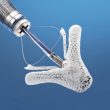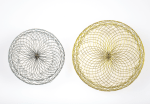Mitral regurgitation (MR) is the most common valvulopathy and full medical treatment at maximal tolerated doses has been shown quite effective to treat it. However, its limited in a group of patients that require valve intervention. At present, the ideal treatment is surgical valve replacement, which is in many cases is not viable because of...
We Should Treat Significant Stable CAD in Patients Undergoing TAVR
Aortic stenosis is associated to significant coronary artery disease (CAD) in nearly 50% of cases. When we decide to treat aortic disease using surgery, it has been established we should also treat heart disease. However, when using transcatheter aortic valve replacement (TAVR), this is still unclear, given that in many occasions we see stable lesions...
Ticagrelor or Prasugrel Post-PCI in Daily Practice Patients
The ISAR-REACT 5 showed a significant reduction in the composite outcome of death, acute myocardial infarction (AMI), or stroke when using prasugrel vs. ticagrelor in patients with acute coronary syndrome (ACS), mainly at the expense of an AMI reduction. While this study changed clinical practice, it has stirred some criticism regarding certain methodological aspects, such...
How Do We Manage Antiaggregation in BARC I Bleeding after AMI?
Dual antiplatelet therapy (DAPT) after acute myocardial infarction (AMI) has been shown useful to reduce thrombotic events, but one of its downsides is bleeding, especially in elderly patients. BARC bleeding type I, also called nuisance bleeding (NB), is of low frequency, but its evolution and impact remain unclear, as does its management. A subanalysis of...
Adherence to P2Y12 Inhibitors in Acute Coronary Syndrome: Prognosis
Non-adherence to medication in patients with acute coronary syndrome (ACS) remains to be solved; the use of polypills and a closer follow up have been tried out (follow up calls and motivation groups). Antiaggregation guidelines recommend dual antiplatelet therapy (DAPT) for at least one year after ACS. Adherence to drug treatment is comprised of multiple...
Left Atrial Appendage Closure Is Safe with the New Devices
Left atrial appendage closure (LAAC) in non-valvular atrial fibrillation with high risk of bleeding has shown promising results with first generation devices (with the Watchman) in the different studies. At present, we have a more modern device, the Watchman FLX, but we do not have much information about it. To gather more data, researchers looked...
The Best of the SOLACI-SOCIME 2022 Main Arena: Day 3
Lecture by Dr. Hector García García – LM-PCI: IVUS and FFR/IFR? Dr. Hector García delivered an excellent presentation on whether we should use intravascular ultrasound (IVUS) or fractional flow reserve (FFR)/instantaneous wave-free ratio (iFR) in the left main coronary artery (LMCA) to consider severe obstruction, since there is significant interobserver variability with angiography. Although the...
High Risk of Bleeding after PCI: More Evidence for Short DAPT
Dual antiaggregation therapy (DAPT) with ASA and P2Y12 during 6 to 12 months is the indicated strategy after DES stenting to reduce ischemic events. However, in patients with elevated risk of bleeding (HBR) guideline and expert recommendations is 1-6 months, since there is plenty of evidence in favor, except for a randomized study, the MASTER...
Two Safe Stents at Two Years in High Bleeding Risk
There is a consistent number of patients presenting high risk of bleeding. In this context, receiving dual antiplatelet therapy (DAPT) for 12 months would not be advisable. Even though the European and American guidelines recommend 1 to 6 months for chronic and acute syndromes in this group, these are often complex PCI cases, which makes...
Should Aspirin Be the Standard of Secondary Prevention of MACE?
Much has been published recently on short term dual antiplatelet therapy (DAPT) both in acute (ACS) and chronic coronary syndrome (CCS) as well as safety of P2Y12 inhibitor monotherapy. When discussing secondary prevention in patients with established coronary artery disease, aspirin (ASA) has been the preferred drug for the prevention of new atherothrombotic events. This...









